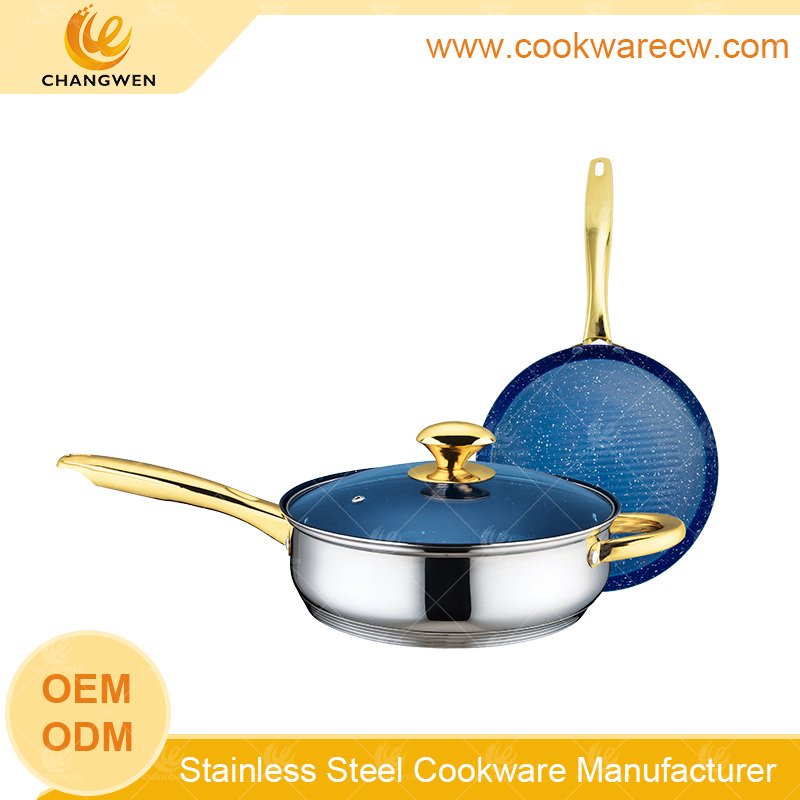Best Quality Stainless Steel Pans
Best quality stainless steel pans wholesale, factory direct sales 304/316 food grade stainless steel cookware, thickened bottom to prevent rust and fall, support OEM customization! Large quantity enjoy special price, minimum order quantity 800 pieces, provide free samples and after-sales warranty, welcome supermarkets/brand customers to discuss cooperation!
Tel: 86-13929001235 (WhatsApp)
E-mail: changwen@cwcooking.com
Best Quality Stainless Steel Pans are made of high-quality stainless steel materials to ensure long-term use without rust or deformation. Our bottom adopts a multi-layer composite structure to effectively improve the heat conduction efficiency, making cooking faster and more precise in heat control. At the same time, the smooth stainless steel surface is easy to clean and maintain, and the appearance is stylish and elegant, suitable for various kitchen decoration styles. Whether it is frying, stir-frying, boiling or stewing, it can show excellent cooking performance.
1. Features
Durability: Best quality stainless steel pans are known for their excellent durability. They are able to resist daily wear and corrosion, ensuring long-term use without deformation or damage.
Easy to clean: Stainless steel has a smooth surface and is not easy to pick up food residues, so it is very easy to clean. Stains and residues can be easily removed with just ordinary detergent and a soft cloth.
Beautiful: Stainless steel pots have an elegant appearance and metallic texture, which can enhance the overall aesthetics of the kitchen. At the same time, they are easy to match with various kitchen decoration styles, adding a touch of fashion to the kitchen.
2. Performance
Thermal conductivity: Although stainless steel itself is not as thermally conductive as metals such as copper or aluminum, modern stainless steel pots usually use a multi-layer composite structure to improve their thermal conductivity efficiency. This design allows heat to be more evenly distributed on the bottom and wall of the pot, thereby speeding up cooking and improving the accuracy of heat control.
Heat retention: Stainless steel pots have good heat retention properties and can maintain the temperature and taste of food during cooking. This makes them very suitable for dishes or soups that need to be kept warm for a long time.
Compatibility: Stainless steel cookware is suitable for a variety of cooking methods, including frying, stir-frying, boiling, stewing, etc. They can also be used safely on a variety of heat sources, such as gas stoves, induction cookers, etc.
3. Research and testing
In order to ensure the quality and performance of best quality stainless steel pans, we, as a cookware manufacturer, will conduct a series of research and tests. These tests include:
Durability test: Evaluate the durability of the cookware by simulating daily use scenarios, including wear test, corrosion test, etc.
Thermal conductivity test: Use professional equipment to measure the heat conduction efficiency of the cookware at different temperatures to ensure that it can meet cooking needs.
Safety test: Check whether there are safety hazards such as overheating and deformation during the use of the cookware. At the same time, the material of the cookware will also be chemically analyzed to ensure that it does not contain harmful substances.
4. Materials
The main material of stainless steel cookware is stainless steel alloy, which is composed of elements such as iron, chromium, and nickel. Among them, chromium is the key element for the corrosion resistance of stainless steel, and its content is usually not less than 10.5%. Nickel helps to improve the strength and toughness of stainless steel. In addition, our high-end stainless steel cookware will also add other elements, such as molybdenum, titanium, etc., to further enhance its performance and quality.
5. Grades
The grades of stainless steel cookware are usually classified according to their materials, processes and performance. The following are some common stainless steel cookware grades and their characteristics:
304 stainless steel: This is one of the most common stainless steel materials, with good corrosion resistance and formability. It is suitable for various cooking scenarios, such as kitchenware, tableware, etc. 304 stainless steel cookware is usually moderately priced and is one of the first choices for consumers.
316 stainless steel: Compared with 304, 316 stainless steel has better corrosion resistance, especially to seawater and chloride corrosion. Therefore, it is more suitable for occasions that require higher corrosion resistance, such as chemical industry, seawater treatment equipment, etc. In the kitchen, 316 stainless steel cookware is usually used for cooking seafood or dishes that require long-term contact with acidic substances.
430 stainless steel: This is a ferritic stainless steel with good thermal conductivity and small thermal expansion coefficient. It is often used to manufacture automotive parts, architectural decoration, etc. 430 stainless steel cookware is relatively rare in the kitchen, but some economical cookware may use this material.
For the best quality stainless steel cookware, they are usually made of high-quality stainless steel and undergo fine craftsmanship and performance testing. These cookware not only have excellent durability and easy cleaning, but also have excellent thermal conductivity and heat preservation performance. At the same time, they have also undergone rigorous safety testing to ensure that they will not cause harm to the human body during use.
Related products
-
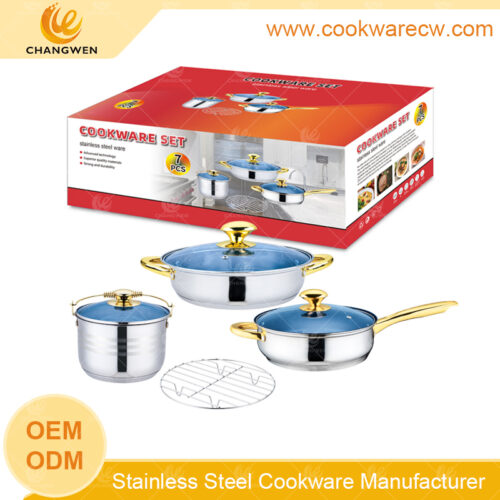
Stainless steel kitchen 7pcs cookware rice cooker with capsule bottom frypan with helper gold plated hollow handle and blue glass wire rack CW-M0701
-
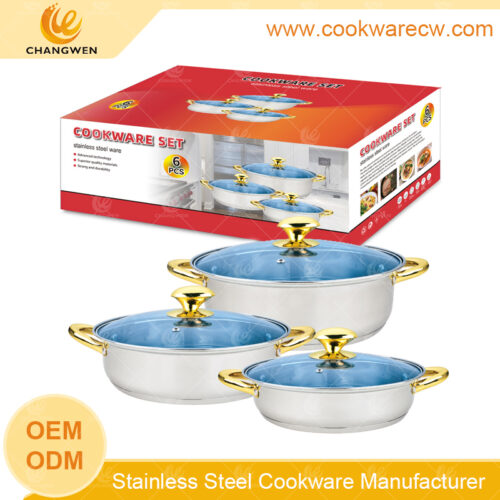
Pots wholesale stainless steel 6pcs rice cooker cookware short pot gold cooking shallow pots with golden handles and blue glass lids CW-M0606
-
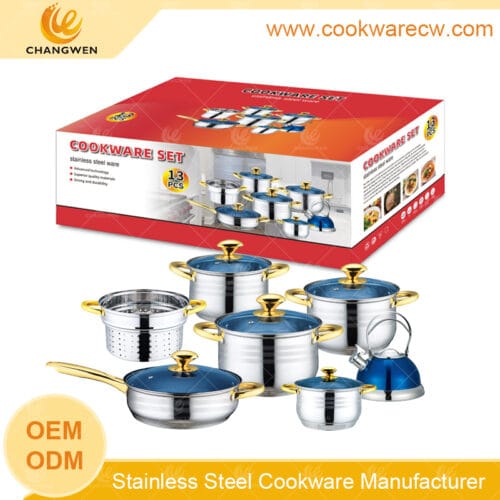
Mercado Libre stainless steel 13pcs cookware set tea kettle pasta pot nonstick frying pan golden handle blue coating CW-M1305
-
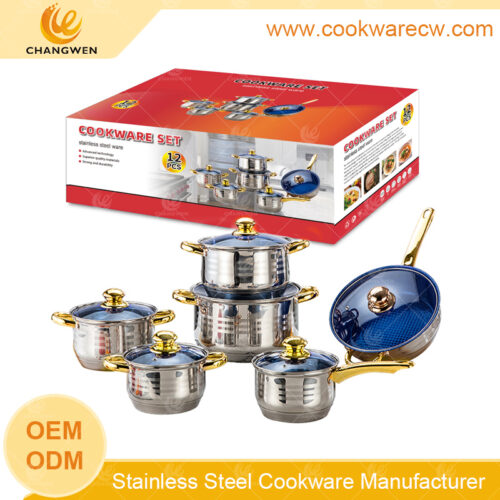
hot sales 12pcs stainless steel cookware set saucepan casserole non-stick frypan with golden handles & knobs & 5-stepped capsule bottom CW-M1202
-
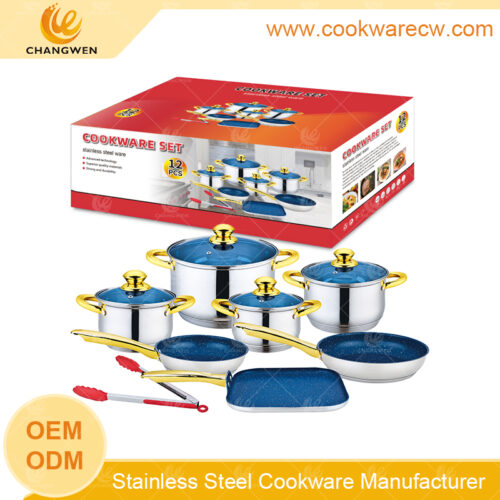
Hot sale SS ollas non-stick coated frying pans and pots stock pot with a kitchenware clip CW-M1204
-
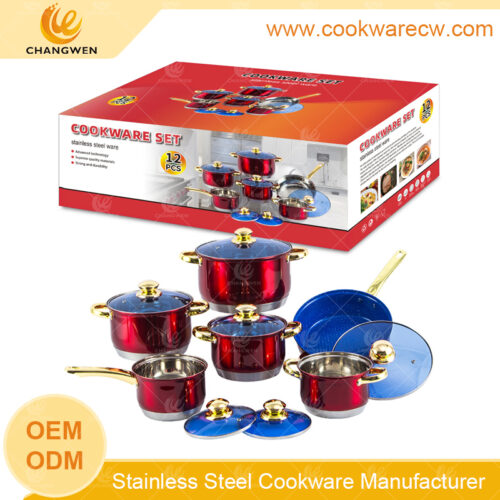
pots wholesale red color outside coating cookware pots non-stick fry pan with stainless steel 430 5-stepped bottom CW-M1225
-
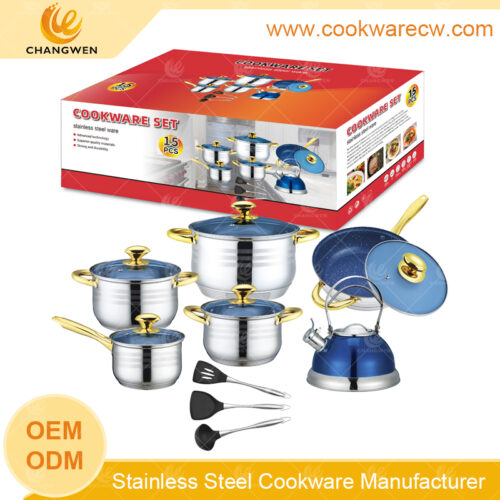
Stainless steel cookware 15pcs cooking sets blue marble nonstick fry pan golden plated handles and knobs capsule bottom 3L whistling tea kettle kitchen tools CW-M1501
-
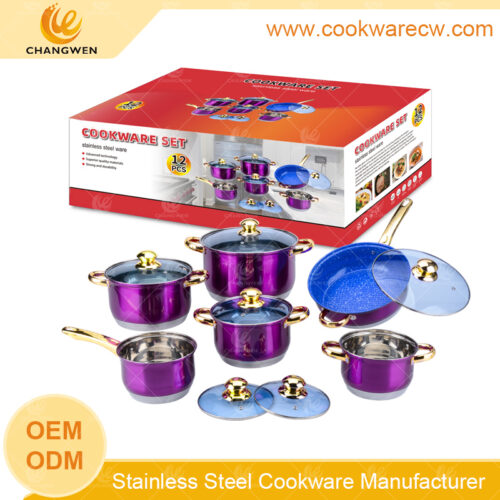
color coating surface stainless steel pots non-stick frypan golden S/S handles and knobs 430 protector for induction CW-M1225

